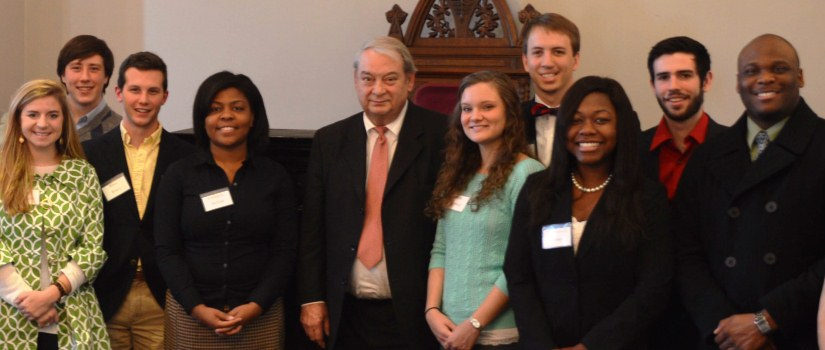In 1998, Dr. Ferid Murad, a physician, pharmacologist and biomedical researcher, was awarded the Nobel Prize in Physiology and Medicine. The award recognized his research demonstrating that nitroglycerin, used commonly in medical applications to ease the painful symptoms of angina, a symptom of heart disease caused by inadequate blood flow to the heart, works by releasing nitric oxide into the body, relaxing smooth muscle tissue and allowing blood flow to increase. Recently the Office of the Vice President for Research invited Dr. Murad to visit the University of South Carolina to meet with students, learn more about biomedical research happening here and give a talk on his decades of research experience. A lightly edited excerpt of his talk is provided below.
I was fortunate to work with Earl Sutherland and Ted Weller [at the University of Virginia]. They discovered cyclic AMP in 1957. Earl trained with Carl and Gerty Cori in Wash. U. There were seven Nobel Laureates that came out of Pharmacology and Biochemistry at that point. So, a wonderful place. Earl was interested—the Coris got the prize for the regulation of phosphorylase, the regulatory enzyme to convert glycogen to glucose—and Sutherland was interested in how epinephrine and glucagon broke down glycogen to make glucose, and then went on to discover cyclic AMP in 1957. And I joined him in 1958....
We first discovered the biological effects of nitric oxide in 1976-77. Today there are 150,000 research papers, and it’s one of the most popular areas in all of medical research.
I worked with cyclic AMP for ten years, as a student and then later when I worked at NIH. But as I finished NIH in 1970 and I went to Virginia, and I decided to switch from cyclic AMP to cyclic GMP. It was a new molecule discovered … by a couple of chemists, and I was very interested in compounds, nucleotides, that might block the activity of cyclic AMP. And I thought perhaps cyclic GMP could also be a messenger like cyclic AMP, and maybe block the activity of cyclic AMP. That’s how I got started on it.
Let me tell you about cell signaling and communication. The first evidence of cell communication got started in the late 1800s. A physician by the name of Beaumont in Michigan had a patient who had a hunting accident with a gunshot wound to his abdomen, and he developed a fistula from his stomach to the exterior. The physician noticed that every time he would eat or see his food, he would secrete gastric fluid through this fistula.
This attracted the attention of Pavlov, in St. Petersburg, Russia. He was a gastrointestinal physiologist. He then created the Pavlovian dogs as you’ll recall from your psychology classes. He created pouches and fistulas in dogs. He showed them food; they too increase their gastric secretions in the pouch, in the exterior. But, then he did a very simple, clever experiment: every time he showed the dogs food, he rang a bell. He repeated it over, and over, and over again, and conditioned the dogs such that he no longer had to show them food, just ring a bell, and they’d get the gastric secretions in the pouch or fistula. He realized that the senses—smell, sight, taste—and the brain were talking to the cellular [level]. He got the Nobel Prize in 1904, the fourth year it was given, for this understanding of cellular communication. We know today that lots and lots of cells talk to each other.
From here, Dr. Murad went on to provide a technical discussion of cell communication and how he and his colleagues set out to discover how nitric oxide serves as a chemical messenger to regulate cyclic GMP, easing the painful symptoms of angina. You can read more about Dr. Murad his groundbreaking research at the Nobel Prize website.
11 December 2014
